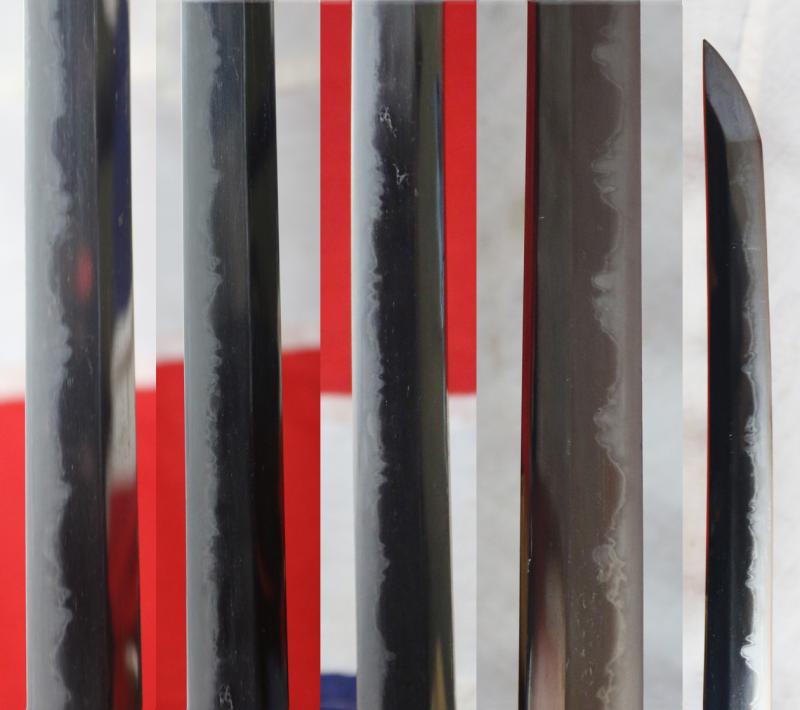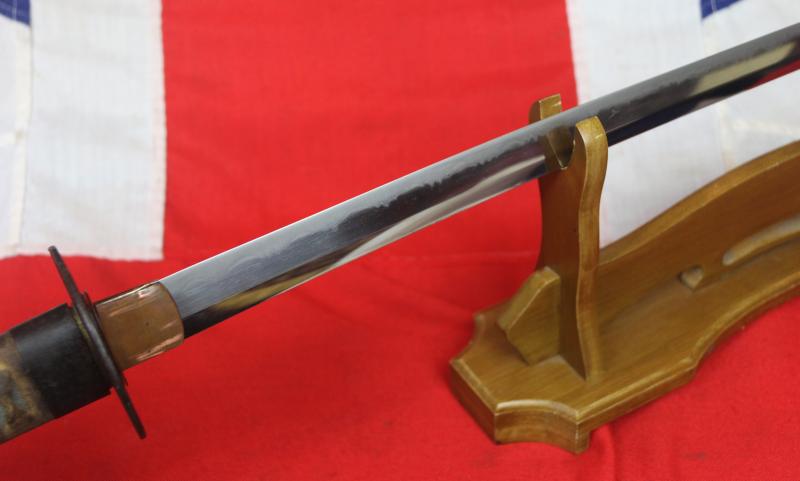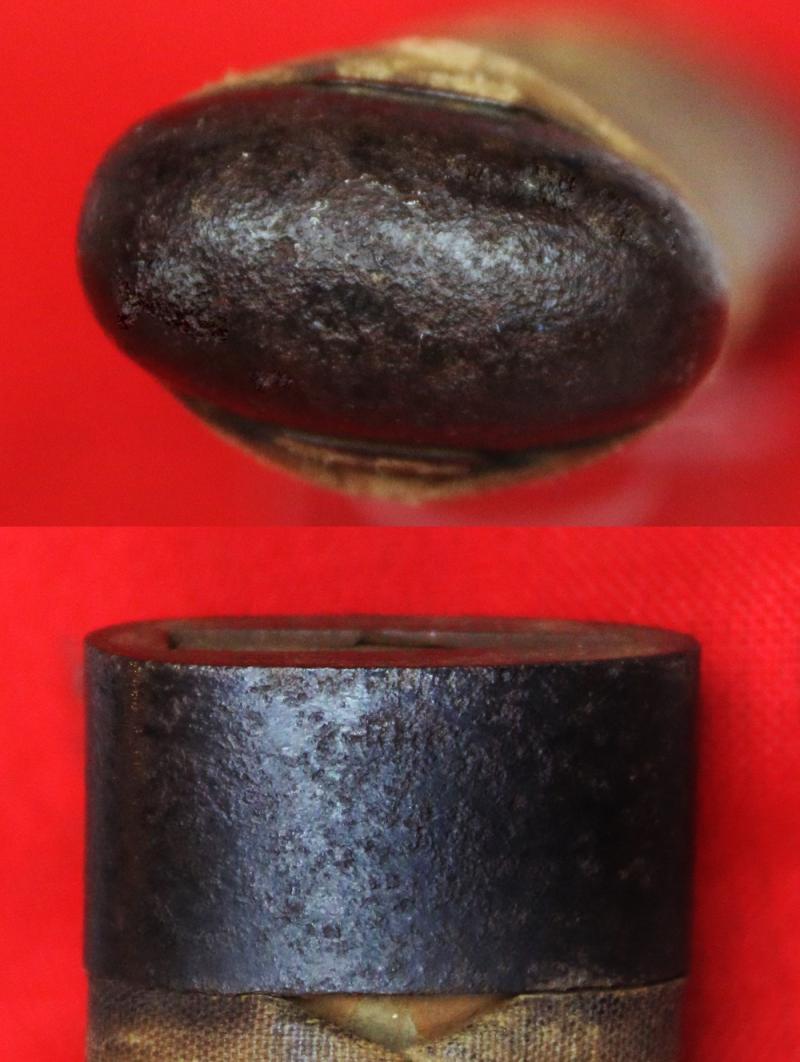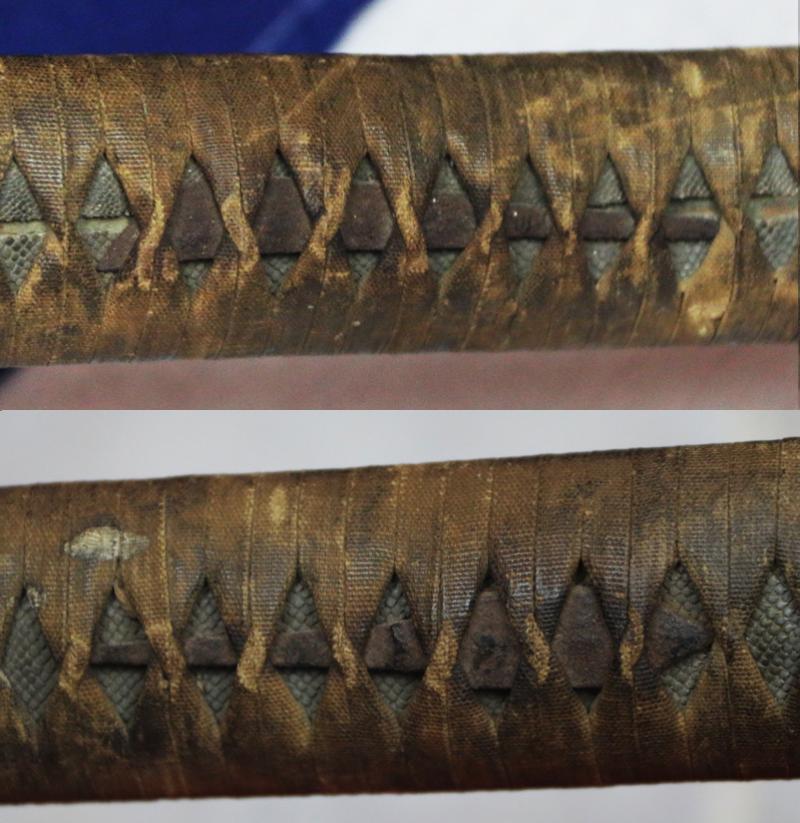A Magnificent and Large Horse Mounted Samurai's Battle Sword Katana, With A Simply Stunning Shinto Blade In Near Mint Condition for Age. The Mounts Are All Completely Original Edo Period.
A beautiful substantial and impressive Bizen tradition war katana, with a very fine classic koshi no hiraita midare hamon. High-ranking warriors sword that were the only samurai permitted to fight on horseback.
Plain tettsu Higo school fuchi kashira in a traditional russet finish. Original Edo tsuka ito wrapped over ancient form menuki of russet iron spear heads, in early yari and naganata form. Round tetsu Higo schookl kinuki tsuba with two udenuki-no-ana. The holes being for the passage of a cord, tying the tsuba to the scabbard.
The saya is very fine, with a sayjiri bottom iron mount, with light ‘cinnabar pink’ urushi lacquer finish, also known as coromandel pink {named from the pink petaled flower} urushi lacquer to the saya, often made with the addition of perilla oil. The condition of both saya is very good just a couple of aged surface nicks
The colour created from urushi lacquer mixed with cinnabar was rewarded to them as the most famous warriors of all the samurai clans of Japan, the Li, and the Takeda.
Samurai endured for almost 700 years, from 1185 to 1867. Samurai families were considered the elite. They made up only about six percent of the population and included daimyo and the loyal soldiers who fought under them. Samurai means one who serves."
Samurai were expected to be both fierce warriors and lovers of art, a dichotomy summed up by the Japanese concepts of bu to stop the spear expanding into bushido (the way of life of the warrior) and bun (the artistic, intellectual and spiritual side of the samurai). Originally conceived as away of dignifying raw military power, the two concepts were synthesised in feudal Japan and later became a key feature of Japanese culture and morality. The quintessential samurai was Miyamoto Musashi, a legendary early Edo-period swordsman who reportedly killed 60 men before his 30th birthday.
In Japan the term samurai evolved over several centuries
In Japanese, they are usually referred to as bushi (武士,) or buke (武家). According to translator William Scott Wilson: "In Chinese, the character 侍 was originally a verb meaning 'to wait upon', 'accompany persons' in the upper ranks of society, and this is also true of the original term in Japanese, saburau. In both countries the terms were nominalized to mean 'those who serve in close attendance to the nobility', the Japanese term saburai being the nominal form of the verb." According to Wilson, an early reference to the word samurai appears in the Kokin Wakashū (905–914), the first imperial anthology of poems, completed in the first part of the 10th century.
Originally, the word samurai referred to anyone who served the emperor, the imperial family, or the imperial court nobility, even in a non-military capacity.It was not until the 17th century that the term gradually became a title for military servants of warrior families, so that, according to Michael Wert, "a warrior of elite stature in pre-seventeenth-century Japan would have been insulted to be called a 'samurai'".
This is a katana was likely made for a senior, high ranking samurai, a seieibushi. based upon horseback in combat, certainly not a light and deeply cursive katana, but a battle sword, made to complete an uncomprimising task of close combat and aggressive close quarter hand to hand swordmanship. Designed as much for cleaving through samurai armour and kabuto helmets in two, as much as defeating another samurai while on horseback. Although samurai would not, one would say, be a cavalry based warrior, all senior samurai would be mounted and thus travel on horseback, and some cavalry type samurai could be deployed in battle, but with differing combat styles depending on what part of Japan they came from. The cavalry troops, being Samurai, had personal retainers that stayed closer to them in the Sonae, carried their weaponry and worked as support units, much like an European squire. They also joined the fight whenever possible (especially in the mounted infantry scenario) and were often responsible of taking heads for their lords.
These foot Samurai were also used as heavy infantry or archers to support the ashigaru lines.
Tactics
Given the fact that the Samurai could directly dismount and operate as infantry, there were some specific tactics for horsemen.
Cavalry in general was only used after the battle was already started, either to deliver a decisive victory or to trying to save the day.
Norikiri
This is a classic charge, where several small groups of five to ten horseman ride consequently (possibly with a wedge formation) into a small area against the enemy lines, to maximize the shock. It was mainly used by heavy cavalry in the East, but given the fact that the ideal target where "weavering" units with low morale or disorganized, even medium cavalry could perform this charge.
The main role of this charge was to create confusion; if it didn't succeed, the cavalry regroups and either retreat or deliver another charge.
Norikuzushi
This is a combined infantry and cavalry charge. The horseman charged first, and after creating mayhem, a second charge is delivered by infantries armed with polearms, which could keep on fighting. The main target for this tactics were ranged units detached by the army. After a Norikuzushi usually follows a Norikiri by the cavalry group
30 inch blade overall 43 inches long in saya.
Code: 25539
7250.00 GBP









